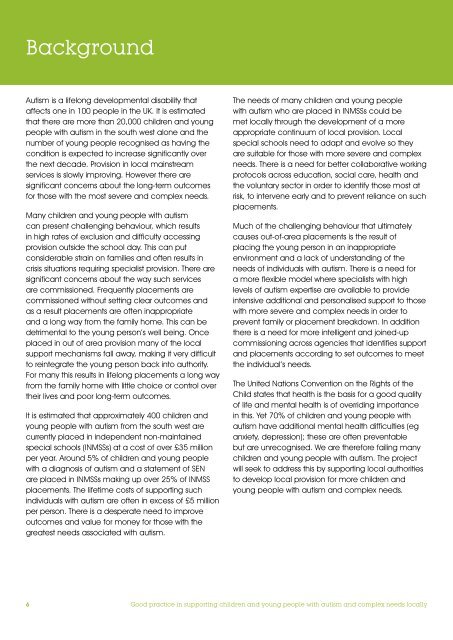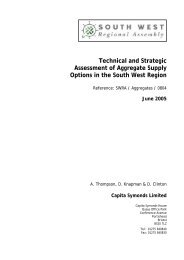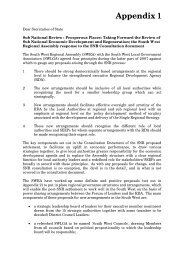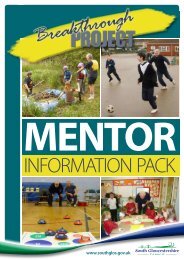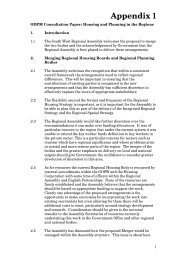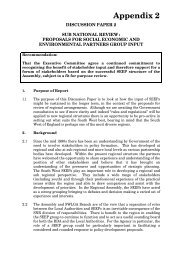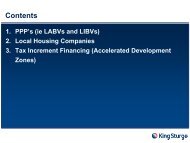Good practice in supporting children and young people with autism ...
Good practice in supporting children and young people with autism ...
Good practice in supporting children and young people with autism ...
- No tags were found...
Create successful ePaper yourself
Turn your PDF publications into a flip-book with our unique Google optimized e-Paper software.
BackgroundSummary of recommendationsAutism is a lifelong developmental disability thataffects one <strong>in</strong> 100 <strong>people</strong> <strong>in</strong> the UK. It is estimatedthat there are more than 20,000 <strong>children</strong> <strong>and</strong> <strong>young</strong><strong>people</strong> <strong>with</strong> <strong>autism</strong> <strong>in</strong> the south west alone <strong>and</strong> thenumber of <strong>young</strong> <strong>people</strong> recognised as hav<strong>in</strong>g thecondition is expected to <strong>in</strong>crease significantly overthe next decade. Provision <strong>in</strong> local ma<strong>in</strong>streamservices is slowly improv<strong>in</strong>g. However there aresignificant concerns about the long-term outcomesfor those <strong>with</strong> the most severe <strong>and</strong> complex needs.Many <strong>children</strong> <strong>and</strong> <strong>young</strong> <strong>people</strong> <strong>with</strong> <strong>autism</strong>can present challeng<strong>in</strong>g behaviour, which results<strong>in</strong> high rates of exclusion <strong>and</strong> difficulty access<strong>in</strong>gprovision outside the school day. This can putconsiderable stra<strong>in</strong> on families <strong>and</strong> often results <strong>in</strong>crisis situations requir<strong>in</strong>g specialist provision. There aresignificant concerns about the way such servicesare commissioned. Frequently placements arecommissioned <strong>with</strong>out sett<strong>in</strong>g clear outcomes <strong>and</strong>as a result placements are often <strong>in</strong>appropriate<strong>and</strong> a long way from the family home. This can bedetrimental to the <strong>young</strong> person’s well be<strong>in</strong>g. Onceplaced <strong>in</strong> out of area provision many of the localsupport mechanisms fall away, mak<strong>in</strong>g it very difficultto re<strong>in</strong>tegrate the <strong>young</strong> person back <strong>in</strong>to authority.For many this results <strong>in</strong> lifelong placements a long wayfrom the family home <strong>with</strong> little choice or control overtheir lives <strong>and</strong> poor long-term outcomes.It is estimated that approximately 400 <strong>children</strong> <strong>and</strong><strong>young</strong> <strong>people</strong> <strong>with</strong> <strong>autism</strong> from the south west arecurrently placed <strong>in</strong> <strong>in</strong>dependent non-ma<strong>in</strong>ta<strong>in</strong>edspecial schools (INMSSs) at a cost of over £35 millionper year. Around 5% of <strong>children</strong> <strong>and</strong> <strong>young</strong> <strong>people</strong><strong>with</strong> a diagnosis of <strong>autism</strong> <strong>and</strong> a statement of SENare placed <strong>in</strong> INMSSs mak<strong>in</strong>g up over 25% of INMSSplacements. The lifetime costs of support<strong>in</strong>g such<strong>in</strong>dividuals <strong>with</strong> <strong>autism</strong> are often <strong>in</strong> excess of £5 millionper person. There is a desperate need to improveoutcomes <strong>and</strong> value for money for those <strong>with</strong> thegreatest needs associated <strong>with</strong> <strong>autism</strong>.The needs of many <strong>children</strong> <strong>and</strong> <strong>young</strong> <strong>people</strong><strong>with</strong> <strong>autism</strong> who are placed <strong>in</strong> INMSSs could bemet locally through the development of a moreappropriate cont<strong>in</strong>uum of local provision. Localspecial schools need to adapt <strong>and</strong> evolve so theyare suitable for those <strong>with</strong> more severe <strong>and</strong> complexneeds. There is a need for better collaborative work<strong>in</strong>gprotocols across education, social care, health <strong>and</strong>the voluntary sector <strong>in</strong> order to identify those most atrisk, to <strong>in</strong>tervene early <strong>and</strong> to prevent reliance on suchplacements.Much of the challeng<strong>in</strong>g behaviour that ultimatelycauses out-of-area placements is the result ofplac<strong>in</strong>g the <strong>young</strong> person <strong>in</strong> an <strong>in</strong>appropriateenvironment <strong>and</strong> a lack of underst<strong>and</strong><strong>in</strong>g of theneeds of <strong>in</strong>dividuals <strong>with</strong> <strong>autism</strong>. There is a need fora more flexible model where specialists <strong>with</strong> highlevels of <strong>autism</strong> expertise are available to provide<strong>in</strong>tensive additional <strong>and</strong> personalised support to those<strong>with</strong> more severe <strong>and</strong> complex needs <strong>in</strong> order toprevent family or placement breakdown. In additionthere is a need for more <strong>in</strong>telligent <strong>and</strong> jo<strong>in</strong>ed-upcommission<strong>in</strong>g across agencies that identifies support<strong>and</strong> placements accord<strong>in</strong>g to set outcomes to meetthe <strong>in</strong>dividual’s needs.The United Nations Convention on the Rights of theChild states that health is the basis for a good qualityof life <strong>and</strong> mental health is of overrid<strong>in</strong>g importance<strong>in</strong> this. Yet 70% of <strong>children</strong> <strong>and</strong> <strong>young</strong> <strong>people</strong> <strong>with</strong><strong>autism</strong> have additional mental health difficulties (eganxiety, depression); these are often preventablebut are unrecognised. We are therefore fail<strong>in</strong>g many<strong>children</strong> <strong>and</strong> <strong>young</strong> <strong>people</strong> <strong>with</strong> <strong>autism</strong>. The projectwill seek to address this by support<strong>in</strong>g local authoritiesto develop local provision for more <strong>children</strong> <strong>and</strong><strong>young</strong> <strong>people</strong> <strong>with</strong> <strong>autism</strong> <strong>and</strong> complex needs.• Strategic plann<strong>in</strong>g: Make effective use of data<strong>and</strong> trends <strong>in</strong> strategic plann<strong>in</strong>g to ensure thereis an appropriate range of provision spann<strong>in</strong>gthe whole spectrum of need <strong>in</strong> order to reducereliance on INMSSs.• Tra<strong>in</strong><strong>in</strong>g: Ensure that multi-tiered <strong>autism</strong> tra<strong>in</strong><strong>in</strong>gis available <strong>in</strong> all agencies <strong>in</strong> each local area <strong>in</strong>order that community professionals can respondappropriately to the needs of <strong>young</strong> <strong>people</strong> <strong>with</strong><strong>autism</strong>, reduc<strong>in</strong>g the risk of placement breakdown.• Cont<strong>in</strong>uum of provision: All local areas shouldensure there is a range of appropriate provisionto respond to the needs of learners across thespectrum, <strong>in</strong>clud<strong>in</strong>g those <strong>with</strong> complex needs thatmay challenge traditional services.• Further education: Local areas should ensure thereis appropriate local further education provision forlearners <strong>with</strong> <strong>autism</strong> <strong>and</strong> complex needs to reducecurrent reliance on INMSS placements (30% of whichare <strong>in</strong> further education <strong>in</strong>stitutions).• Short breaks: Local authorities should developappropriate specialist short-break provision,<strong>in</strong>clud<strong>in</strong>g overnight breaks, for <strong>young</strong> <strong>people</strong> <strong>with</strong><strong>autism</strong> <strong>and</strong> complex needs <strong>in</strong> order to reducereliance on INMSSs (a majority of such placements<strong>in</strong>volve part-time residential provision).• Mental health: Child <strong>and</strong> adolescent mental healthservices (CAMHS) should develop more preventativeservices <strong>and</strong> provide better access to appropriatetherapeutic services for <strong>young</strong> <strong>people</strong> <strong>with</strong> <strong>autism</strong><strong>and</strong> complex needs.• Multi-agency work<strong>in</strong>g: Local authorities shouldensure there is effective multi-agency work<strong>in</strong>g toenable families to receive <strong>in</strong>tegrated targetedsupport which can mirror that offered by INMSSs.• Outreach: Local authorities should develop specialistprovision that can act as the hub of expertise forthe local authority, provid<strong>in</strong>g expertise, tra<strong>in</strong><strong>in</strong>g <strong>and</strong>outreach to other services so they become betterequipped to manage the higher level of needs.• Family support programmes: Local authorities shouldconsider <strong>in</strong>troduc<strong>in</strong>g family support programmes such asthose <strong>in</strong> Bristol to help prevent family breakdown <strong>and</strong> theneed for more specialist provision.• Input of carers: Children’s trusts should follow theexample of Autism <strong>in</strong> M<strong>in</strong>d <strong>in</strong> Sunderl<strong>and</strong> <strong>and</strong> <strong>in</strong>viteparents <strong>with</strong> <strong>children</strong> <strong>with</strong> <strong>autism</strong> spectrum disorders(ASD) to have an <strong>in</strong>put <strong>in</strong>to strategies for <strong>children</strong> <strong>and</strong><strong>young</strong> <strong>people</strong> <strong>with</strong> <strong>autism</strong> <strong>and</strong> learners <strong>with</strong> learn<strong>in</strong>gdifficulties or disabilities.• Third sector provision: The public sector shouldconsider us<strong>in</strong>g the expertise offered by the third sectorwhen develop<strong>in</strong>g specialist provision.• Regional plann<strong>in</strong>g: Local authorities <strong>in</strong> the south westmight consider form<strong>in</strong>g an <strong>autism</strong> consortium similar tothat <strong>in</strong> Greater Manchester, which achieves economiesof scale through sub-regional strategic plann<strong>in</strong>g.• Person-centred plann<strong>in</strong>g: Local authorities shouldpromote more use of person-centred plann<strong>in</strong>g to putthe <strong>young</strong> person <strong>and</strong> their family at the centre ofthe plann<strong>in</strong>g process <strong>and</strong> support <strong>young</strong> <strong>people</strong> toachieve their aspirations.• Transitions: Local authorities should considerdevelop<strong>in</strong>g an adult <strong>and</strong> transition <strong>autism</strong> service so<strong>young</strong> <strong>people</strong> <strong>with</strong> <strong>autism</strong> can access appropriatesupport to live effectively <strong>in</strong> community sett<strong>in</strong>gs, havetheir needs anticipated <strong>and</strong> lead more fulfill<strong>in</strong>g lives.• Integrated provision: Local authorities shouldconsider develop<strong>in</strong>g a comprehensive <strong>in</strong>tegrated<strong>autism</strong> service, which <strong>in</strong>cludes education optionsthrough special schools <strong>and</strong> a resource baseattached to a ma<strong>in</strong>stream school, social careoptions through extended activities, short breaks <strong>and</strong>residential provision, <strong>and</strong> effective <strong>in</strong>put from health,<strong>and</strong> outreach <strong>and</strong> tra<strong>in</strong><strong>in</strong>g. Such provision significantlyreduces reliance on INMSS placements.• Commission<strong>in</strong>g: Local authorities should agree clearoutcomes <strong>with</strong> providers when commission<strong>in</strong>g placesfor <strong>young</strong> <strong>people</strong> <strong>with</strong> <strong>autism</strong> <strong>and</strong> complex needs. Thismakes it easier for local authorities to demonstrate valuefor money <strong>and</strong> INMSSs to demonstrate outcomes.6 <strong>Good</strong> <strong>practice</strong> <strong>in</strong> support<strong>in</strong>g <strong>children</strong> <strong>and</strong> <strong>young</strong> <strong>people</strong> <strong>with</strong> <strong>autism</strong> <strong>and</strong> complex needs locally <strong>Good</strong> <strong>practice</strong> <strong>in</strong> support<strong>in</strong>g <strong>children</strong> <strong>and</strong> <strong>young</strong> <strong>people</strong> <strong>with</strong> <strong>autism</strong> <strong>and</strong> complex needs locally 7


